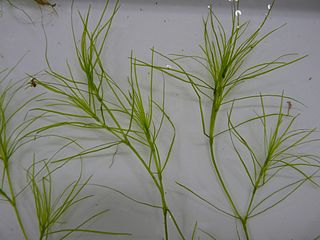Related Research Articles

Wagner is a city in Charles Mix County, South Dakota, United States. The population was 1,490 at the 2020 census. The city is served by Wagner Municipal Airport.
Haya is a Bantu language spoken by the Haya people of Tanzania, in the south and southwest coast of Lake Victoria. In 1991, the population of Haya speakers was estimated at 1,200,000 people. Its closest relative is the Nyambo language and It is also closely related to the languages of southwest Uganda such as Nkore-Kiga, Rutooro and Runyoro which all form a group called "Rutara"
Guyanese Creole is an English-based creole language spoken by people in Guyana. Linguistically, it is similar to other English dialects of the Caribbean region, based on 19th-century English and has loan words from African, Indian, Arawakan, and older Dutch languages.

Desulfovibrio is a genus of Gram-negative sulfate-reducing bacteria. Desulfovibrio species are commonly found in aquatic environments with high levels of organic material, as well as in water-logged soils, and form major community members of extreme oligotrophic habitats such as deep granitic fractured rock aquifers.
An IETF BCP 47 language tag is a standardized code or tag that is used to identify human languages in the Internet. The tag structure has been standardized by the Internet Engineering Task Force (IETF) in Best Current Practice (BCP) 47; the subtags are maintained by the IANA Language Subtag Registry.

The ricefield rat is a species of rat found throughout Southeast Asia.

Tanycytes are special ependymal cells found in the third ventricle of the brain, and on the floor of the fourth ventricle and have processes extending deep into the hypothalamus. It is possible that their function is to transfer chemical signals from the cerebrospinal fluid to the central nervous system.

Najas graminea, also known as ricefield water-nymph is a species of aquatic plant found in freshwater habitats, especially still or slow-moving waters, like ponds and rice fields. It grows to a maximum length of 30 cm. The flowers are monoecious. The flowering season is from July to September.</ref>
The 305th Infantry Brigade was a formation of the British Army organised from surplus Royal Artillery (RA) personnel retrained as infantry towards the end of the Second World War.

Desulfovibrio desulfuricans is a Gram-negative sulfate-reducing bacteria. It is generally found in soils, waters, and the stools of animals, although in rare cases it has been found to cause infection in humans. It is particularly noted for its ability to produce methyl mercury. Also the 'reductive glycine pathway', a seventh route for organisms to capture CO2, was discovered in this species. Since these bacteria are killed by exposure to atmospheric oxygen, the environmental niches most frequently occupied by these bacteria are anaerobic. Desulfovibrio desulfuricans 27774 was reported to produce gene transfer agents
Desulfovibrio acrylicus is a bacterium from the genus of Desulfovibrio which has been isolated from marine sediments from the Wadden Sea.
Desulfovibrio aerotolerans is a Gram-negative, mesophilic, sulphate-reducing and oxygen tolerant bacterium from the genus of Desulfovibrio which has been isolated from activated sludge in Denmark.
Desulfovibrio alcoholivorans is a bacterium from the genus of Desulfovibrio which has been isolated from alcohol industry waste water in France.
Desulfovibrio alkalitolerans is an alkalitolerant and sulphate-reducing bacterium from the genus of Desulfovibrio which has been isolated from a district heating plant in Skanderborg in Denmark.
Desulfovibrio aminophilus is a Gram-negative, mesophilic, non-spore-forming, amino acid degrading and sulfate-reducing bacterium from the genus of Desulfovibrio which has been isolated from an anaerobic lagoon from a dairy wastewater treatment plant in Santa Fe de Bogota in Colombia.
Desulfovibrio arcticus is a Gram-negative, psychrotolerant, sulfate-reducing and motile bacterium from the genus of Desulfovibrio with a single polar flagellum which has been isolated from water from permafrost from the Barents Sea.
Desulfovibrio biadhensis is a Gram-negative, non-spore-forming, anaerobic, mesophilic, slightly halophilic, sulfate-reducing and motile bacterium from the genus of Desulfovibrio which has been isolated from a thermal spring in Tunisia.
Anaerosinus glycerini is a bacterium from the genus of Anaerosinus which has been isolated from freshwater mud in Germany.
Desulfovibrio capillatus is a Gram-negative and sulfate-reducing bacterium from the genus of Desulfovibrio which has been isolated from an oil field separator in the Gulf of Mexico.
Desulfovibrio ferrireducens is a psychrotolerant bacterium from the genus of Desulfovibrio which has been isolated from permanently cold sediments from Fjord in Svalbard.
References
- 1 2 Parte, A.C. "Desulfovibrio". LPSN .
- 1 2 3 "Desulfovibrio burkinensis". www.uniprot.org.
- ↑ Ouattara, AS; Patel, BK; Cayol, JL; Cuzin, N; Traore, AS; Garcia, JL (April 1999). "Isolation and characterization of Desulfovibrio burkinensis sp. nov. from an African ricefield, and phylogeny of Desulfovibrio alcoholivorans". International Journal of Systematic Bacteriology. 49 Pt 2: 639–43. doi: 10.1099/00207713-49-2-639 . PMID 10319487.
- ↑ "Details: DSM-6830". www.dsmz.de.